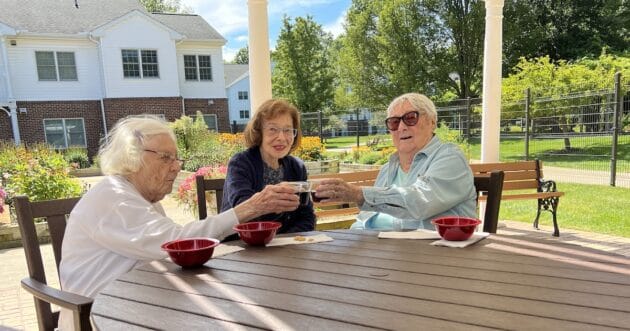Falls aren’t just accidents; they’re predictable and largely preventable events. Research from the CDC shows falls are the number one cause of injuries in people age 65 or older. There are several reasons why seniors fall, including having mobility or balance issues, reduced muscle strength or poor vision. Wearing improper footwear can make it easy to slip on an icy sidewalk or a damp kitchen floor. Some seniors also experience weakness or dizziness from their medications. And while it’s difficult to prevent every type of accident, there are several precautions you can take to decrease your risk for a fall.
Whether you’re living independently at home or considering senior living options, these evidence-based fall prevention tips will help you maintain your active lifestyle while reducing your risk of injury.
10 Fall Prevention Tips for Seniors
Every year, one in four adults aged 65 and older experiences a fall, making fall prevention a critical concern for seniors and their families. Because a fall can drastically affect your lifestyle, preventing one is key to keeping you active, healthy, and as independent as possible. Here are a few fall prevention tips that will help decrease your risk:
1. Clear Out Clutter and Remove Hazardous Rugs
Start your fall prevention journey by taking a look around your current living space. Do you have throw rugs or low furniture like ottomans or coffee tables? If so, it’s time to consider removing those items, especially from high-traffic areas like hallways and entryways. If you must keep these items, ensure they have a non-slip backing and lie flat against the floor.
Key actions:
- Remove or secure loose rugs and mats
- Keep walkways clear of furniture, electrical cords, and clutter
- Ensure stairs and walkways are free of objects
- Organize your home to make it more accessible
2. Balance Exercises for Seniors
Exercise programs that focus on balance and strength training can significantly reduce the risk of falling. The most effective exercises for balance include tai chi, yoga, and specific balance training exercises. Regular physical activity not only improves muscle strength and flexibility but also enhances coordination and reaction time, critical factors in preventing falls.
The key is consistency; even 15-20 minutes of balance-focused exercise three times a week can make a meaningful difference. Start slowly and progress gradually, always prioritizing proper form over intensity.
3. Optimize Lighting Throughout Your Home
Poor lighting contributes to many falls, especially during nighttime bathroom trips. Ensure all areas of your home are well-lit, and consider motion-activated night lights for hallways and bathrooms.
Lighting improvements:
- Install motion-sensor night lights
- Use LED bulbs for brighter, longer-lasting illumination
- Ensure light switches are easily accessible at room entrances
- Keep flashlights in bedside tables and common areas
4. Review Medications with Healthcare Professionals
Multiple medications can increase fall risk through side effects like dizziness, drowsiness, or low blood pressure. The next time you visit your doctor or pharmacist, arm yourself with a list of your current medications. This way, you can discuss any negative interactions they might have that could cause a fall.
Important steps:
- Bring all medications (including over-the-counter drugs) to appointments
- Ask about side effects that could affect balance
- Discuss the timing of medications to minimize side effects
5. Install Safety Equipment and Assistive Devices
Strategic placement of grab bars, handrails, and other safety equipment can provide crucial support when you need it most.
Essential safety installations:
- Grab bars in bathrooms (shower, tub, and toilet areas)
- Handrails on both sides of staircases
- Shower chairs for bathing safety
6. Choose Proper Footwear for Fall Prevention
Your choice of footwear significantly impacts your stability and fall risk. You might love your sparkly, gold heels or your floppy, soft slippers, but it may be time to retire that type of footwear. It’s important to wear shoes that fit your feet perfectly and provide good support.
Ideal footwear features:
- Properly fitted shoes with low heels
- Non-slip, textured soles
- Secure fastenings (laces, velcro, or buckles)
- Good arch support and cushioning
- Avoid walking in stockinged feet on smooth floors
7. Maintain Regular Vision and Hearing Screenings
Have you noticed any recent changes in your vision or hearing? Being able to see and hear clearly is key in preventing falls, so make sure you’re keeping your annual appointments at the eye doctor and hearing center.
Screening recommendations:
- Annual comprehensive eye exams
- Update prescription glasses or contacts as needed
- Regular hearing evaluations
- Promptly address any sudden changes in vision or hearing
8. Use Non-Slip Solutions in High-Risk Areas
Bathrooms and kitchens present the highest risk for slip-and-fall accidents due to water and smooth surfaces.
Non-slip safety measures:
- Install non-slip mats in bathtubs and showers
- Use non-slip mats near sinks and wet areas
- Keep towels and bath mats dry and properly placed
9. Take Your Time During Daily Routines
Rushing and not taking your time can increase your fall risk dramatically. Establish safe routines that allow you to move deliberately and maintain balance.
Safe routine practices:
- Sit on the edge of the bed for a moment before standing
- Rise slowly from chairs to avoid dizziness
- Take breaks during physical activities
10. Maintain Social Connections and Ask for Help
Isolation can lead to decreased physical activity and confidence in moving around, which can increase your risk for a fall. Stay connected with others, get involved in your community, and don’t hesitate to ask for assistance when needed.
Social safety strategies:
- Participate in group exercise classes
- Maintain regular contact with family and friends
- Stay engaged in community activities
Exercises for Balance: Everyday Movement
You don’t need a gym membership or special equipment to improve your balance. Simple everyday movements can significantly strengthen your stability. Try standing on one foot while brushing your teeth, practicing heel-to-toe walking when checking the mail, or doing calf raises while waiting for your morning coffee. These exercises for balance can be seamlessly integrated into your daily routine, making it easier to build strength and coordination without setting aside dedicated workout time.
Unique Living Options for a Safe, Vibrant Lifestyle at Silver Maples
Implementing these fall prevention strategies doesn’t have to be overwhelming. Start with one or two changes and gradually build your safety routine. Remember, the goal isn’t to eliminate all risks, it’s to reduce them while maintaining your independence and quality of life.
Silver Maples Retirement Neighborhood offers a variety of senior living options designed to fit your lifestyle. Plus, all residential accommodations include a 24-hour alert system at no additional charge, so you can rest assured that if an emergency were to occur, assistance is available. Contact us today to schedule your personal tour to see all that our beautiful community has to offer.


